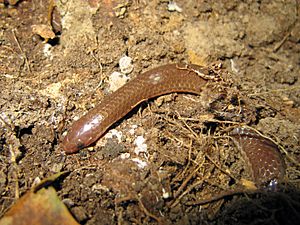Eastern worm snake facts for kids
The eastern worm snake (Carphophis amoenus amoenus) is a small, non-venomous snake found in the eastern parts of North America. It's a type of colubrid snake, which means it's part of a large family of snakes that are not venomous. These snakes are special because they are native only to the Eastern Woodlands region. You can find them from Massachusetts in the northeast, all the way south to Alabama, and west to Illinois. Even though they can be quite common in some areas, you might not see them often. This is because they love to live underground or hide under things like rocks, logs, and piles of leaves.
Quick facts for kids Eastern worm snake |
|
|---|---|
 |
|
| Scientific classification |
|
| Kingdom: | Animalia |
| Phylum: | Chordata |
| Class: | Reptilia |
| Order: | Squamata |
| Suborder: | Serpentes |
| Family: | Colubridae |
| Genus: | Carphophis |
| Species: | |
| Subspecies: |
C. a. amoenus
|
| Trinomial name | |
| Carphophis amoenus amoenus (Say, 1825)
|
|
| Synonyms | |
|
|
Contents
What Do Eastern Worm Snakes Look Like?
Eastern worm snakes are quite small. Most adults are about 19 to 28 centimeters (7.5 to 11 inches) long. The longest one ever found was about 34 centimeters (13.4 inches). Their skin is smooth and shiny, and they usually don't have any patterns. They can be tan to dark brown on top. Their belly is a pretty pink color, which sometimes extends a little onto their sides.
These snakes have a short tail that ends in a pointy, spine-like scale. Females are usually longer than males, but their tails are shorter. Their head is small and pointed, about the same width as their neck. They have tiny, dark eyes.
How to Tell Them Apart
It can be tricky to tell the eastern worm snake apart from other small, brown snakes.
- The western worm snake (Carphophis vermis) has brighter colors.
- Other snakes like earth snakes (genus Virginia) and red-bellied snakes (Storeria occipitomaculata) have rougher scales and don't have the spine-tipped tail.
- The southeastern crowned snake (Tantilla coronata) has a dark head and a dark band around its neck.
Where Do Eastern Worm Snakes Live?
You can find eastern worm snakes in many states across the eastern U.S. This includes southern Connecticut, southwestern Massachusetts, southeastern New York, New Jersey, southeastern Pennsylvania, Delaware, Maryland, Virginia, eastern West Virginia, North Carolina, South Carolina, northern Georgia, and Alabama. They also live in the Appalachian Mountains of Kentucky and Tennessee.
In some places, like Massachusetts and Rhode Island, these snakes are protected. This means special efforts are made to keep their populations safe.
How Eastern Worm Snakes Live
Eastern worm snakes are mostly burrowers, which means they spend a lot of time underground. This is why you don't see them very often! They use their small, pointed heads to push into cracks and soft soil. They are most active from spring to fall. During the hottest parts of summer, they stay hidden to avoid getting too hot or drying out. They prefer forests with lots of leaf litter and shady trees.
These snakes don't move around much. However, males tend to travel farther than females.
What They Eat
Eastern worm snakes are carnivores, which means they eat other animals. Their favorite food is earthworms. They might also eat other soft-bodied creatures they can fit into their mouths, like insect larvae.
Who Eats Them?
Many animals prey on eastern worm snakes. These include other snakes, birds like thrushes, American robins, and barn owls, and even opossums. Sometimes, they are accidentally killed by cars on roads. Flooding and other natural events can also affect their numbers. Sadly, human activities like destroying their habitats or using insecticides can also harm them.
How They Defend Themselves
If you pick up an eastern worm snake, it might release a stinky musk from its tail end. It might also try to burrow between your fingers or poke your hand with its tail spine. But don't worry, they are completely harmless to humans and will not try to bite you.
Eastern Worm Snake Babies
Eastern worm snakes usually mate in the spring. You can sometimes see the developing eggs through the female's skin in late spring. Females lay their eggs between early June and mid-July. They usually lay 2 to 8 eggs at a time.
The eggs are laid in hidden spots, like under rocks, inside rotting logs, or in old sawdust piles. The mother snake often stays near her eggs. The eggs are smooth and long, about 16 to 25 millimeters (0.6 to 1 inch) long. They hatch in August or early September. When they hatch, the baby snakes are about 100 millimeters (4 inches) long.
How Many Eastern Worm Snakes Are There?
In places where the habitat is just right, eastern worm snakes can be found in large numbers. For example, one researcher and his students found over 100 of them in just one hour in Kentucky! They are known to be the most common snake in northern Virginia, with over 200 snakes per hectare (about 2.5 acres) in some areas.
Images for kids


